 |
 |
![]()
| GILLIES DOUGLAS NEIL-CAPTAIN-NX76360 |
| MEDICAL OFFICER 2/1 HEAVY BATTERY (ARTILLERY) |
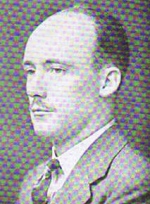
Douglas Neil Gillies was born in Sydney 24 February 1914. He was educated at the Marist College, Darlinghurst and obtained his medical qualification through the University of Sydney Medical School, graduating in 1939. The Medical School Year Book of 1939 had the following picture and comments.
‘HE IS FEASTED AT THE BANQUET AND DISTINGUISHEDAT THE BALL”
“Doug came to Medicine from Marist Brothers”, Darlinghurst. A lover of books, he made full use of the Reading Room during the earlier years of Medicine, seeking there, no doubt, some seclusion from the admiring gazes which concentrated on his rapidly increasing forehead. The fact that he has been mistaken for an honorary speaks volumes for his clinical ability and impressive manner. Hobbies : Surfing, sitting in the sun, and accepting seats in trams offered him by school boys.”
Following graduation Douglas commenced his residency at St Vincent’s Hospital. However, this was cut short when he enlisted in the AAMC as a Captain on 20 November 1940. That appointment ended on 4 September 1941. The next day he was enlisted into the AIF as a Medical Officer with the rank of Captain and appointed to the 2/1 Heavy Battery (Artillery).
He was in Darwin in late 1941 as the Medical Officer to the above unit. The Heavy Battery became a component of “Sparrow Force”. This was a small force and comprised the following-
- a small headquarters
- 2/40 Battalion
- 18th Anti Tank Battery
- 2/11 Field Company
- 2/1 Fortress Engineers
- 2/1 Fortress Signals
- 2/1 Heavy Battery (Artillery)
- 2/2 Independent Company
- 2/12 Field Ambulance
- 75 Light Aid Detachment
- Others, including British elements
Clearly many of the above units were only elements of units. For example, the 2/12 Field Ambulance was just a detachment and only had 2 Medical Officers (Major Roy Stevens and Captain Les Poidevin).
In all there were 5 Medical Officers in the Force. In addition to Stevens, Poidevin and Gillies there was Captain Max Brown (MO to the 2/40 Battalion) and Captain C.R.Dunkley (MO 2/2 Independent Company). On Timor there was also a Dutch doctor Henri Hekking. He was the resident doctor in Koepang and had his wife and two sons with him. (Hekking later distinguished himself as the Medical Officer with the American POWs (survivors of USS Houston and members of the 131st Artillery Unit) on the Burma end of the Burma Thailand Railway. An article on Hekking will appear later on the website. ).
The Force moved from Darwin in the first week of December 1941 (after Japan had invaded Malaya and the attack on Pearl Harbour). The Force arrived in Timor mid December and was located near Koepang.
On 19 and 20 February 1942 the Japanese invaded using paratroopers and troops landed from transports. There are differing opinions of the relative strengths of the Jap invasion force and the defenders. Sources suggest 18,000-20,000 Japs and 1,500 to 3,000 allied defenders. The actual numbers are not important. The numerical superiority of the Japs is obvious. Following a short gallant battle, the members of Sparrow Force became POWs on 23 February 1942.
There is little definitive information that I can locate about where Douglas Gillies was over the next 42 months. With the assistance of Mrs Sylvia Gillies, widow of Doug Gillies, and others, locations of incarceration have been identified. I am obliged to Jack Howland ( NX36871 2/1 Heavy Artillery) for information about Capt Gillies- Extracts from Jack Howland’s letter follow:-
‘Doug was not an original member of the unit. He came to the unit after we were in Darwin. We left Darwin a couple of days after the Japs came into the war (7 December 1941) and went to Koepang (now Kupang) in Dutch Timor. Doug was taken Prisoner of War with the rest of the unit on 23 February 1942. In September 42 we went by boat to Surabaya in Java and then by train to Tandjong Priok- Batavia (now Jakarta). Just after Christmas some of the unit went to Changi and on up to Thailand (including me). Doug stayed in Priok.
I did not see Doug again till the early 1970s in the Irish Club in Brisbane. He told me he had been a doctor in Borneo. He was a General Practitioner in Lismore in the 60s. Later he moved to Kenmore. He invited me out to his home for a drink and I vaguely remember he worked for the Department of Veterans Affairs in Brisbane.
Darcy Smith (a great mate of Doug’s) rang me a couple of years later? And told me Doug had died”.
In 2003 the writer visited Captain (Dr) Les Poidevin in Adelaide. On the day of the visit to Adelaide, Les Poidevin invited (Dr) Harry Medlin to visit. Harry had been a Lieutenant in Timor as an officer in the 2/1 Fortress Engineers and was a fellow Prisoner of War. Poidevin said that he lost contact with Doug Gillies whilst they were on Java. Poidevin wrote a number of books. One titled “Samurais and Circumcisions”, is helpful as it places Doug in Tandjong Priok in 1942, then at Makasura Camp January to March 1943 and then finally Cycle Camp April to August 1943. Thereafter Poidevin has no mention of Gillies’ whereabouts. The final reference to Gillies in the Poidevin book is “post war he returned to General Practice and died in 1980”.
In January 2007, the writer established telephone contact with Sylvia Gillies, Doug’s widow. She was able to fill some of the gaps in the above story. Sylvia said that Doug remained in Java to the end of the war. (This is consistent with a nominal roll prepared by Lieutenant Alan Carrick NX71121 2/1 Heavy Battery which showed against the detail of Doug Gillies -“Recovered Java 1945”).
Material has generously been provided by Sylvia Gillies, which includes copies of his diary notes 20 February 42 to 6 January 43 and copy of a research paper which Doug co-authored with a Captain (Doctor) W de Graaf, Netherland East Indies Army titled “Observations on Healthy Plasmodium Vivax Carriers”. Copies of both of these documents follow this article.
The diary notes, although in extreme abbreviated form give some indication of conditions. Some points which I noted.-
- Close proximity to the Japs during the period of hostilities.
- Mention of the Dutch doctor Henri Hekking.
- Entry 27.2.42 John Winter arrived (possibly JSB Winter VX39389 Dental Officer.
- Mention of “Ops” 28 Feb and 5-7 March.
- Movement from Koepang to Java on 25 Sept 42.was via Dilli .
The Research document is extremely interesting. It reveals -
- Doug was in the Mater Dolorosa POW Hospital , Batavia 1943 and 1944
- This research was conducted in captivity.
- Detailed observations of some malarial patients are recorded.
- The research was assisted by earlier research conducted in Holland.
- There were two hospitals in Batavia. St Vincent’s Hospital (Surgical cases) and
Mater Dolorosa (Infectious diseases).
Dr Harry Medlin (referred to above - not a doctor of medicine) has written about his experiences as a POW on Timor and Java and some of his articles are to be produced elsewhere on the website. We are fortunate these articles are available
as so little has been recorded of the experiences of members of Sparrow Force
(and indeed Gull (Ambon) and Lark Force (Rabaul)). In Harry Medlin’s article titled “Bakayaro” on page 6 he says “On the day that we marched out of Oesapa Besar (23/9/42) to board the “Dai Nichi Maru” our Garrison RMO Captain D.V.(Doug) Gillies and I were together and we agreed that it would have to be three years at least before we could have any expectation of freedom.” On page 10 of the article, he says “However, within my experience of them (the Medical Officers), all of our Doctors did their jobs: it might be said that they were fortunate to have jobs to do and I believe our Doctors would not disagree with that. Our own Doctors were Max Brown (2/4 Battalion). Doug Gillies (Garrison), Roy Stevens and Les Poidevin (2/12 Field Ambulance) and John Winter (Dental Unit). All deserved credit…….”.
\
Following capitulation by the Japanese on 15 August 1945 the POWs return to Australia by a number of different routes. Captain Doug Gillies was discharged from the Army on 12 April 1946. I am indebted to Doug’s widow Sylvia Gillies (nee Stubbs) for the following detail of Doug’s post war life –
“After the war on his return to Sydney he did a course in Tropical Medicine and Hygiene (DTM at Sydney University) and we were married on 2.10.1946.
Doug’s preference was to practice tropical medicine and with this in mind he joined the British Colonial Medical Service and was posted to Labuan in British North Borneo in January 1946.
I was able to join him after three months and during the three years I spent there gave birth to two sons – John (13.9.47) and Neil (10.11.49) both in Kuala Belait in Brunei, Doug being the only doctor on the island.
When his long leave was due Doug intended to go to England direct and study for and obtain a MRCP (Member of the Royal College of Physicians). I returned to Australia to see my mother (it was my intention to stay 6 months and then join Doug in England). However the Korean War had broken out and being reasonably close to the action there were many rumours of escalation particularly when General McArthur wanted to invade China (before he was eventually recalled to the USA by President Truman). Doug said he didn’t fancy being a POW twice and putting his wife and family at risk and resigned from the British Colonial Medical Service and returned to Sydney in September 1950.
While he considered various options Doug leased a general practice in Double Bay for a year, and whilst there suffered bouts of both viral pneumonia and glandular fever. He considered it would be better if we moved to a warmer climate and bought a practice in Lismore in the northern rivers district of NSW. We moved there early 1951.
Over the many years in Lismore he developed a really bad back problem which, as a GP, was a great handicap moving around and bending over frequently. (I understand from a survey carried out many ex-POW’s had similar complaints). Finally in February 1970 he joined the Department of Veterans Affairs in Brisbane (more of a desk job). He retired when he turned 65 (24.2.79). We went overseas for 5 months and on our return he rejoined the Department as a casual where he remained until his death – a secondary from malignant melanoma (previously removed) on his left shoulder – on 29.12.80.”
Article written by Lt Col Peter Winstanley with the initial assistance of Jack Howland (NX36871 2/1 Heavy Battery (Artillery). Reference was made to a number of books including, “Doomed Battalion” by Peter Henning and “Samurais and Circumcisions” by Les Poidevin. Comments were also taken from former Lt (Dr) Harry Medlin (2/1 Fortress Engineers-Timor), Lt (later Sir) John Carrick (NX70514 18 Anti Tank Battery), Tom Uren (NX38458 2/1 Hvy Bty). Particular assistance was provided in January 2007 by Sylvia Gillies the widow of Douglas Gillies .
Documents following-
- Sketch by Geoff Tyson of POWs on beach at Oesapa Besar
- Research paper de Graaf and Gillies (Copied from original carbon copy).
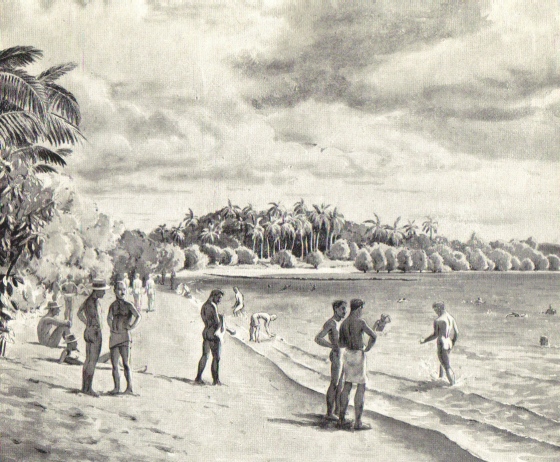
This sketch of POWs bathing at Oesapa Besar beach was done by Geoff Tyson (Lance Corporal) 2/40 Battalion. In the fore ground are Captains (Medical Officers) Poidevin, with hat, and Doug Gillies with towel.
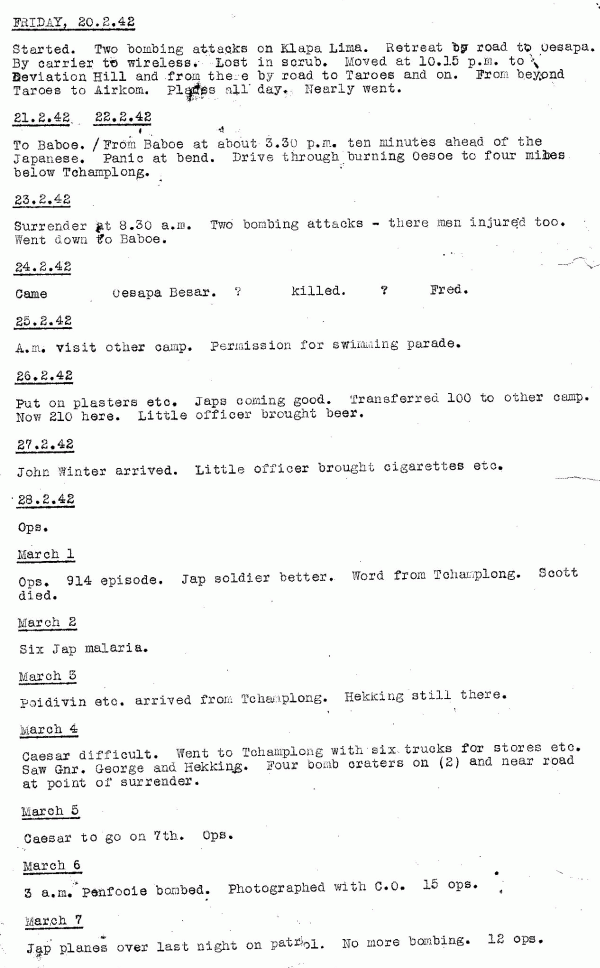
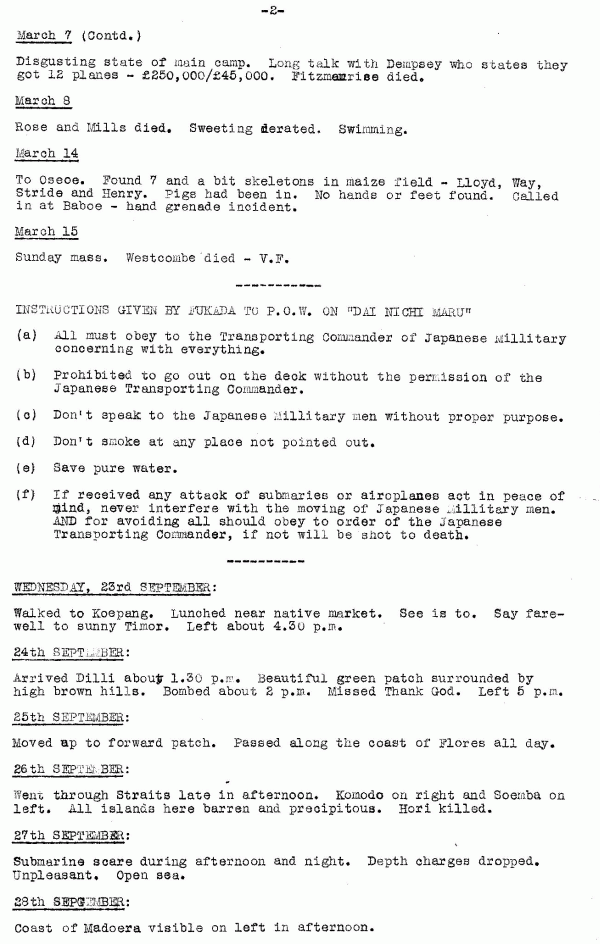
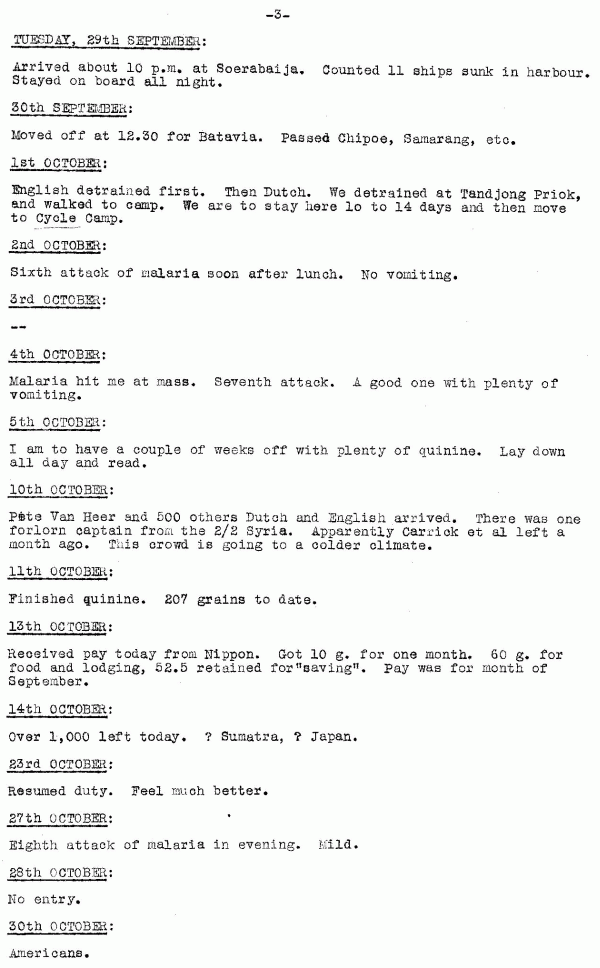
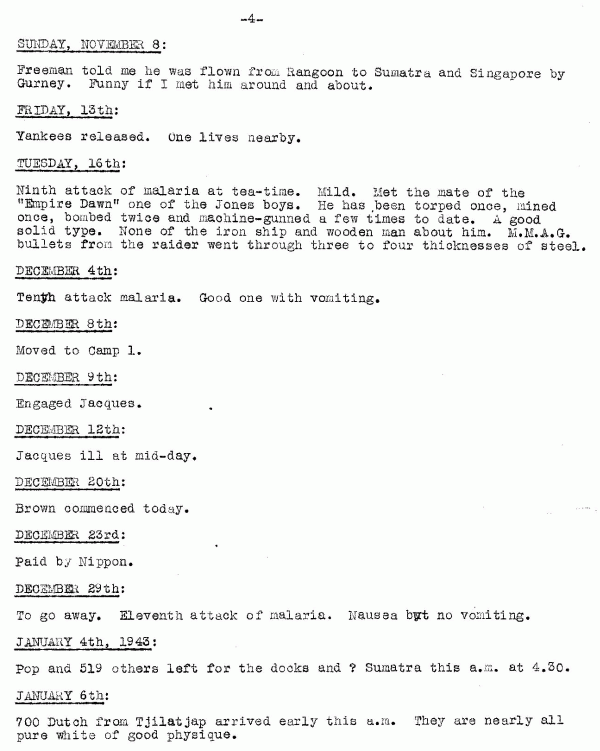
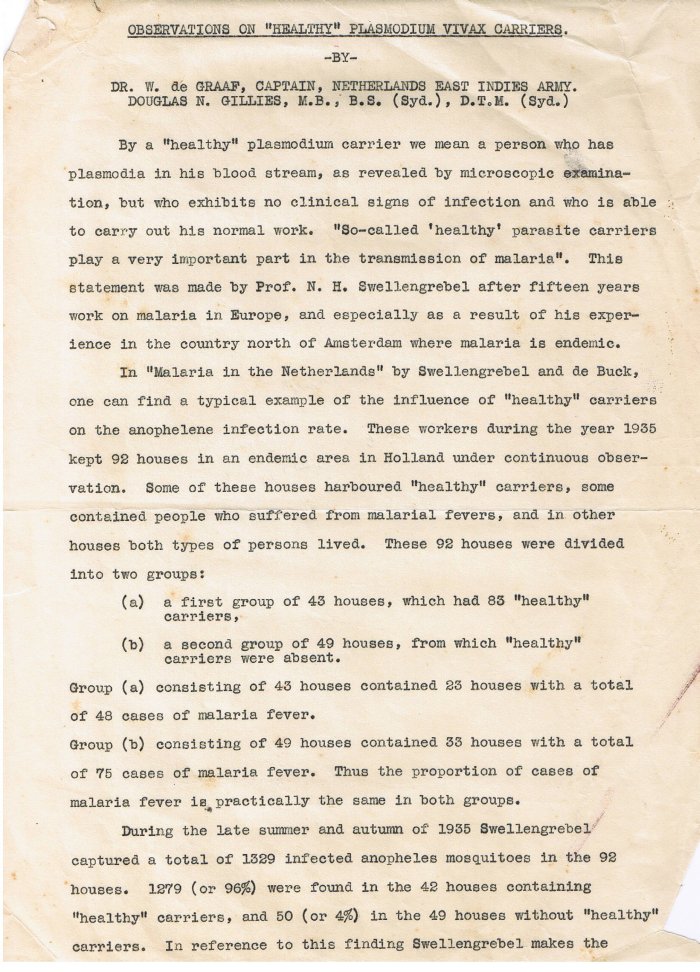
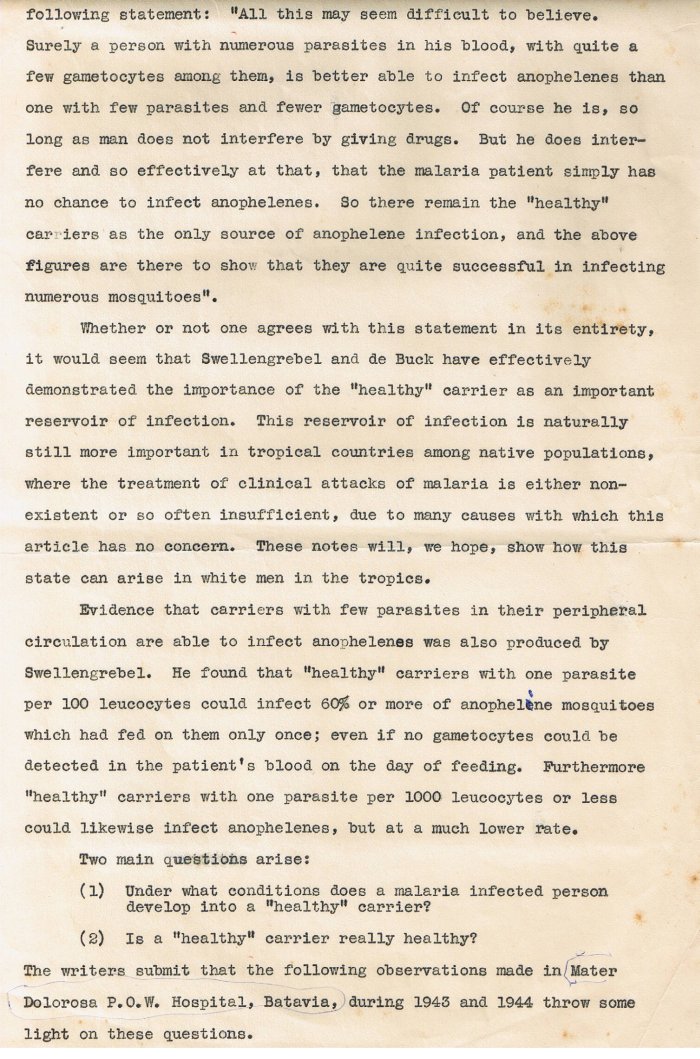
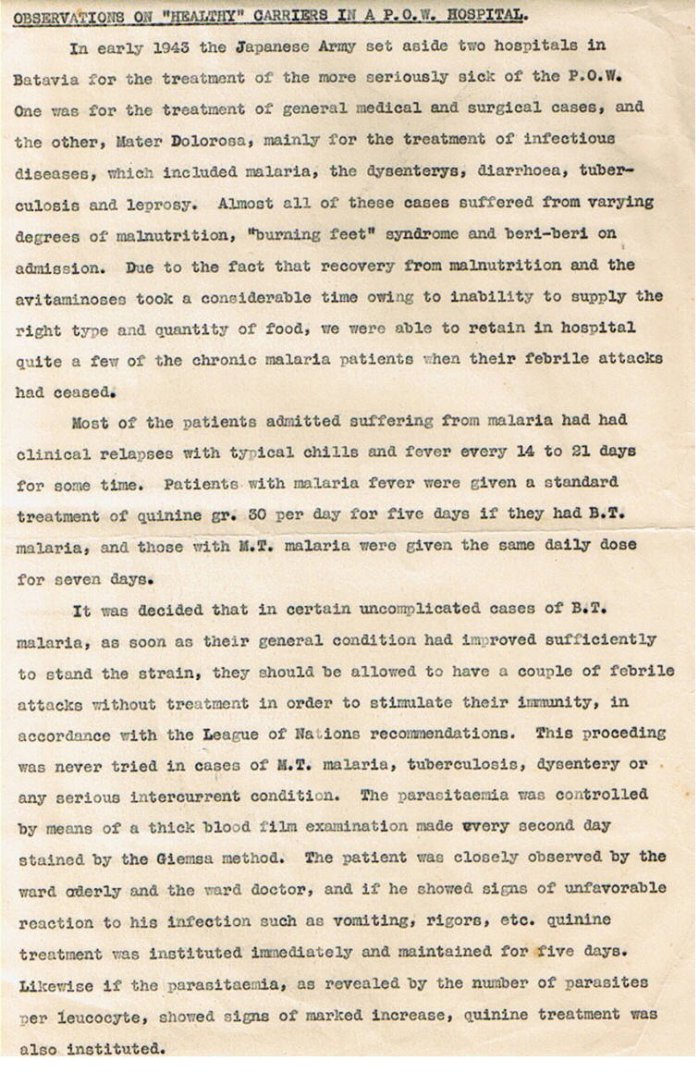
|
|